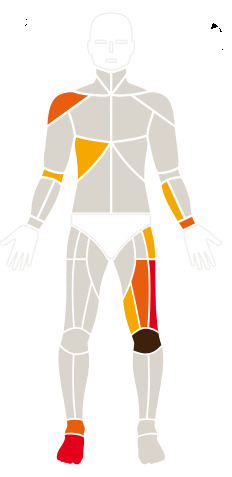Medical Thermography
Muscoskeletal Health
A Proactive Approach .

Join the Health Optimization Revolution
Musculoskeletal injuries affect people of all ages and activity levels. These conditions impact bones, muscles, ligaments, tendons, and nerves, and they can interfere with daily life. Whether you are an athlete aiming for top performance, a worker dealing with physical strain, or someone struggling with posture-related issues, musculoskeletal problems can take a toll on your quality of life. While traditional diagnostic tools like X-rays and MRIs are still essential, thermography offers a new way to explore and improve musculoskeletal health.
What is Thermography?
Thermograph , is a non-invasive technique that creates images of the heat your body gives off. These thermal images show variations in skin temperature, which can reveal inflammation, changes in blood flow, or tissue problems.
Unlike X-rays or MRIs, thermography doesn’t use radiation or require direct contact with your body. This makes it a safe and painless option for anyone, especially for repeat scans over time.
How Thermography Detects and Assesses Injuries
Musculoskeletal injuries often show up as inflammation, poor circulation, or abnormal tissue activity—all of which can be captured by thermography.
For example:
Backed by Research
Research has shown the value of thermography in diagnosing musculoskeletal problems. Different studies found thermography to be highly effective at detecting early-stage muscle injuries in athletes, with accuracy similar to MRIs. Other studies highlighted thermography’s ability to measure temperature differences linked to conditions like tendon issues and chronic pain.
Monitoring Recovery and Treatment
Thermography is not just for diagnosing injuries—it also helps track recovery and measure how well treatments are working. For instance, clinicians can observe changes in thermal patterns during follow-up scans. A decrease in heat around an injury site might show reduced inflammation and healing progress. On the other hand, persistent heat could suggest that a treatment isn’t working and adjustments are needed.
Preventing Injuries Before They Happen
One of the most powerful uses of thermography is preventing injuries. By identifying small thermal changes that indicate stress or dysfunction, thermography allows for early intervention before a problem becomes serious.
For athletes or active individuals, regular thermographic screenings can reveal imbalances, overuse patterns, or misalignments that increase injury risk. In workplaces, routine scans can detect ergonomic issues or repetitive strain injuries, making it easier to implement solutions like better posture or modified tasks.
Thermography also helps people in higher-risk groups, such as older adults or those with pre-existing conditions. It can reveal thermal changes tied to joint stiffness, muscle weakness, or age-related wear and tear. This information allows clinicians to design targeted plans to preserve mobility, prevent falls, and enhance overall function.
A Holistic Approach to Musculoskeletal Health
At Revive, thermography is a game-changer in musculoskeletal care. It provides a deeper understanding of injuries, monitors recovery, and helps prevent future problems. By detecting subtle thermal patterns that reflect what’s happening inside the body, this tool offers a safe, precise, and proactive way to manage musculoskeletal health.
